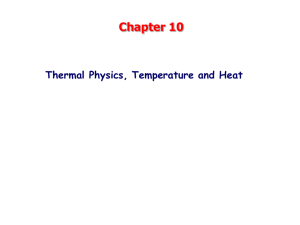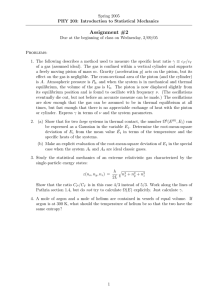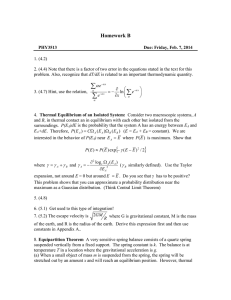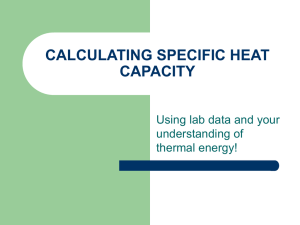Chapter 10 Thermal Physics, Temperature and Heat
advertisement
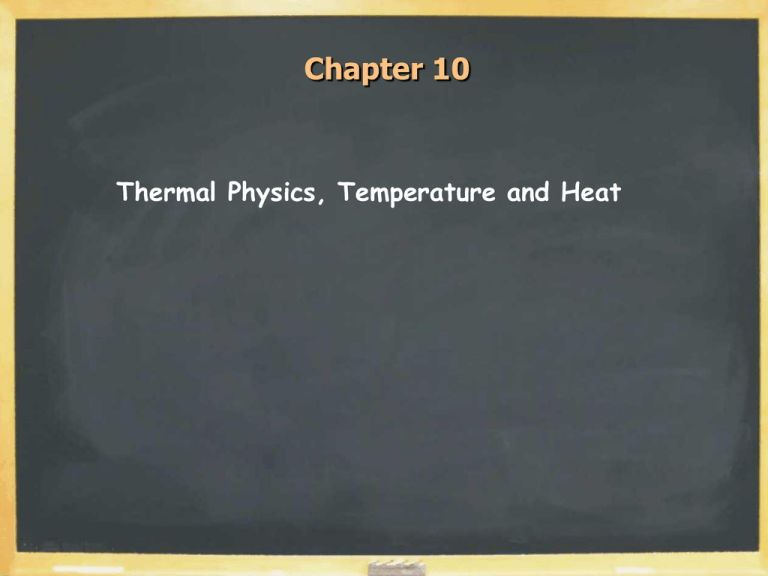
Chapter 10 Thermal Physics, Temperature and Heat Some Vocabulary Thermodynamics: • Study of energy transfers (engines) • Changes of state (solid, liquid, gas...) Heat: • Transfer of microscopic thermal energy Thermal Equilibrium: • Condition after two objects are in thermal contact and finish exchanging heat. Zeroth Law of Thermodynamics If A is in thermal equilibrium with B and B is in thermal equilibrium with C, A is in thermal equilibrium with C. allows definition of temperature objects at thermal equilibrium have same T Heat moves from high T to low T objects Thermometers Exploit temperature sensitivity of • volume or length • • • • pressure electric resistance color average particle speeds Temperature Scales Celsius: • Water freezes at 0 C, boils at 100 C Farenheit: • Water freezes at 32 F, boils at 212 F 9 T (in F) 32 T (in C) 5 5 T (in C) T (in F) 32 9 Absolute Temperature Kelvin Scale: T (in C) T (in K) 273.15 • Lowest possible energy at T=0 K • Pressure -> 0 at T=0 • Ideal gas law only makes sense for absolute scale Some Temperatures Lowest laboratory T ~ 10-7 K At RHIC, T ~ 1013 K In big bang, T ~ 1040 K or more Fahrenheit Scales Most common scale used in the US Temperature of the freezing point is 32º Temperature of the boiling point is 212º 180 divisions between the points Thermal Expansion At high T increased molecular vibration pushes molecules further apart L T L0 Coefficient of Linear Expansion Property of Material Area and Volume Expansion Each dimension (length, width & height) stretch L T L0 A T , 2 A0 V T , 3 V0 Example 10.1 The coefficient of volume expansion of water at 20 C is =2.07x10-4 K-1. If the average depth of the ocean is 4000 m, by what height would the oceans rise due to thermal expansion if Earth’s temperature rises by 2 C? 54 cm If you live on a beach where the slope of the beach is one meter height per 100 meters, how much of your beach would disappear? 54 m These are overestimates by factor of ~2 since land also expands Global Warming http://www.ncdc.noaa.gov/oa/climate/globalwarming.html T rose ~ 0.4 C in last ~ 100 years T rose ~ 0.25 C in last ~ 25 years Sea levels rise ~ 1 mm per year Melting Antarctic ice caps are important Application: Bimetallic Strip Used in thermostats Water is Weird Density INCREASES between 0ºC and 4 ºC Maximum density of water is 1000 kg/m3 at 4 ºC Density of ice = 917 kg/m3 .... Ice floats! Ideal Gas Law For sufficiently dilute gas, pressure is: • proportional to number • proportional to temperature • inversely proportional to volume PV nRT pressure temperature Ideal Gas Constant volume number of moles Ideal Gas Law PV nRT • One mole is NA =6.023x1023 molecules (number of 12C atoms in 12 g of 12C) • R=8.31 Nm/moleK Microscopic Perspective PV Nk BT Boltzmann’s constant k=1.38x10-23 Nm/K = R/6.023x1023 number of molecules Example 10.2 Pure helium gas is admitted into a leak-proof cylinder containing a movable piston. The initial volume, pressure, and temperature of the gas are 15 L, 2.0 atm, and 300 K. If the volume is decreased to 12 L and the pressure increased to 3.5 atm, find the final temperature of the gas. (Assume helium behaves as an ideal gas.) 420 K Example 10.3 A vertical cylinder of crosssectional area 0.050 m2 is fitted with a tight-fitting, frictionless piston of mass 5.0 kg (see figure). If there is 3.0 mol of an ideal gas in the cylinder at 500 K, determine the height h at which the piston will be in equilibrium under its own weight. h=2.4 m Kinetic Theory of Gases We wish to show: 3 PV E 2 Derivation N p x P A t p x 2mvx Area=d2 2d t vx 2 1 px vx 2 2 1 m mvx KEone part . A t dA V 3V 2 PV KEall part.s 3 Molecular Interpretation of Temperature Using KE=(3/2)PV & PV=NkT, 3 KE Nk BT 2 1 2 3 mv k BT 2 2 Temperature is proportional to the average kinetic energy of a single molecule: Internal Energy In a monatomic gas, the translational K.E. is the only type of energy the molecules can have 3 U nRT 2 U is the internal energy of the gas. In a polyatomic gas, one also has rotational and vibrational energy & (3/2) --> bigger number Speed of Molecules The root-mean-square (rms) speed of molecule is: 1 2 3 mv k BT 2 2 3 kB T 3RT vrms m M Lighter molecules move faster Example 10.4 A cylinder contains a mixture of helium (He) and argon (Ar) gas in equilibrium at a temperature of 150°C. (a) What is the average kinetic energy of each type of molecule? 8.76x10-21 J (b) What is the rms speed of each type of molecule? He: 1.62 km/s, Ar: 514 m/s
